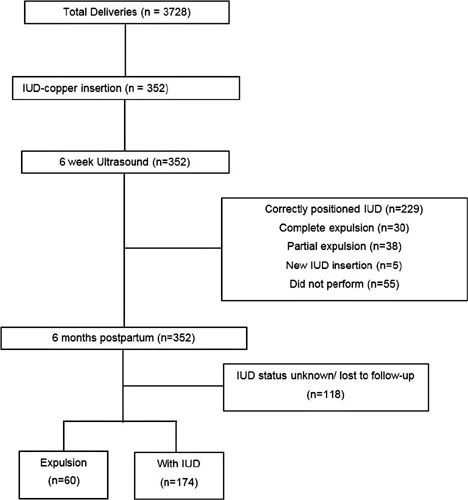Summary
Revista Brasileira de Ginecologia e Obstetrícia. 2023;45(1):31-37
To evaluate the expulsion and continuation rates of the copper intrauterine device (IUD) inserted in the immediate postpartum period in a Brazilian public university hospital.
In the present cohort study, we included women who received immediate postpartum IUD at vaginal delivery or cesarean s March 2018 to December 2019. Clinical data and the findings of transvaginal ultrasound (US) scans performed 6-weeks postpartum were collected. The expulsion and continuation rates were assessed 6-months postpartum using data from the electronic medical records or by telephone contact. The primary outcome was the proportion of IUDs expelled at 6 months. For the statistical analysis, we used the Student t-test, the Poisson distribution, and the Chi-squared test.
There were 3,728 births in the period, and 352 IUD insertions were performed, totaling a rate of 9.4%. At 6 weeks postpartum, the IUD was properly positioned in 65.1% of the cases, in 10.8% there was partial expulsion, and in 8.5% it had been completely expelled. At 6 months postpartum, information was obtained from 234 women, 74.4% of whom used IUD, with an overall expulsion rate of 25.6%. The expulsion rate was higher after vaginal delivery when compared with cesarean section (68.4% versus 31.6% respectively; p = 0.031). There were no differences in terms of age, parity, gestational age, final body mass index, and newborn weight.
Despite the low insertion rate of copper IUDs in the postpartum period and a higher expulsion rate, the rate of long-term continuation of intrauterine contraception was high, indicating that it is a useful intervention to prevent unwanted pregnancies and to reduce short-interval birth.

Summary
Revista Brasileira de Ginecologia e Obstetrícia. 2021;43(4):291-296
To evaluate whether continuation rates with the 52-mg levonorgestrelreleasing intrauterine system (LNG-IUS) up to 5 years after placement differed between women using the method exclusively for contraception and those using the device for medical reasons alone.
A retrospective cohort study was conducted in a family planning clinic with 5,034 LNG-IUS users: 4,287 using the method exclusively for contraception and 747 for medical reasons alone. The continuation rate at 1 to 5 years of use was calculated by life table analysis.
Initially, the continuation rate was significantly higher in the contraception group: 85.8 versus 83.4 and 77.4 versus 76.0 per 100 women-years in the 1st and 2nd years of use, respectively. There were more discontinuations due to bleeding/spotting in the medical reasons group in the first two years. The discontinuation rate according to reason for use was not significantly different from the third to the fifth year of use. No women discontinued due to amenorrhea in either group.
The continuation rate was significantly higher in the contraception group in the first two years of use. Amenorrhea was not a reason for discontinuation in either group, suggesting that counselling in this respect was adequate. Nevertheless, counselling could perhaps have been better with regards to the expected long period of bleeding and spotting in the first two years after placement.